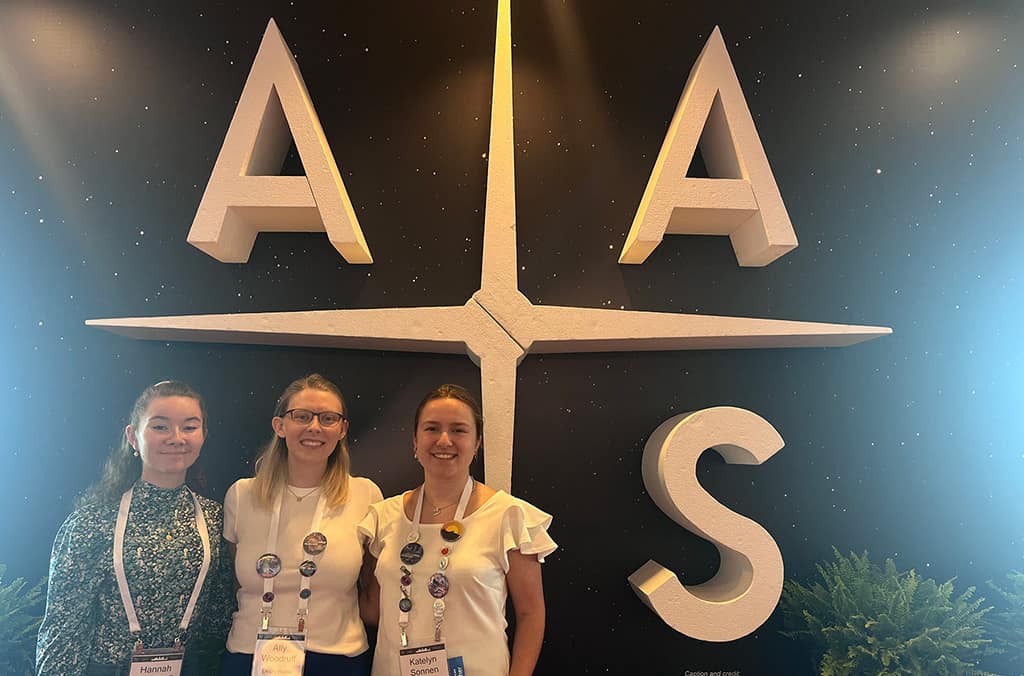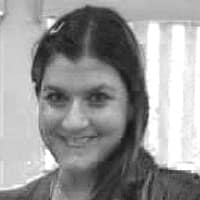Eagle Researchers Present at American Astronomical Society Meeting

Hannah Woodruff, Allyson Woodruff and Katelyn Sonnen, at the American Astronomical Society’s latest meeting (Photo: Embry-Riddle/ Hannah Woodruff)
Embry-Riddle Aeronautical University students Hannah Woodruff, Allyson Woodruff and Katelyn Sonnen recently presented research at the 244th American Astronomical Society meeting, held in Madison, Wisconsin.
Hannah Woodruff, who is earning her master’s degree in Data Science, presented her interdisciplinary thesis research, which involves enhancing stellar simulations, using various machine learning and deep learning methods to make finding the apsidal constant easier. She is working on the research with Dr. Gamage Dumindu Samaraweera, assistant professor in the Department of Mathematics, and Dr. Jason Aufdenberg, associate professor and program coordinator for Astronomy and Astrophysics.
The apsidal constant provides insights into the internal structure and density distribution of a star, and the students’ research could further refine the accuracy of stellar models. Hannah Woodruff received funding from the College of Arts and Sciences, as well as from NASA’s Florida Space Grant Consortium, to attend the conference.
Allyson Woodruff, who is earning her Ph.D. in Engineering Physics, shared research on a technique she is co-developing with Dr. Ted von Hippel, professor in the Department of Physical Sciences, and other students on using white dwarfs to determine the age of different stellar populations in the Milky Way. Using data, they are also evaluating how each of three stellar populations could have formed in the Milky Way's early years. She was awarded funding for the conference from Embry-Riddle’s Office of Undergraduate Research.
Katelyn Sonnen, who is earning her bachelor’s degree in Astronomy and Astrophysics, presented research she is working on with Dr. Aufdenberg that focuses on creating an expanded spectral atlas for Sirius A, the brightest star in the night sky. Comparing spectroscopic data from two telescopes with a synthetic spectra model, the research aims to create a more accurate atlas and provide more insight into Sirius' atmosphere. She received funding from the Office of Undergraduate Research and the Physical Sciences Department to attend the conference.
Hannah Woodruff, who is earning her master’s degree in Data Science, presented her interdisciplinary thesis research, which involves enhancing stellar simulations, using various machine learning and deep learning methods to make finding the apsidal constant easier. She is working on the research with Dr. Gamage Dumindu Samaraweera, assistant professor in the Department of Mathematics, and Dr. Jason Aufdenberg, associate professor and program coordinator for Astronomy and Astrophysics.
The apsidal constant provides insights into the internal structure and density distribution of a star, and the students’ research could further refine the accuracy of stellar models. Hannah Woodruff received funding from the College of Arts and Sciences, as well as from NASA’s Florida Space Grant Consortium, to attend the conference.
Allyson Woodruff, who is earning her Ph.D. in Engineering Physics, shared research on a technique she is co-developing with Dr. Ted von Hippel, professor in the Department of Physical Sciences, and other students on using white dwarfs to determine the age of different stellar populations in the Milky Way. Using data, they are also evaluating how each of three stellar populations could have formed in the Milky Way's early years. She was awarded funding for the conference from Embry-Riddle’s Office of Undergraduate Research.
Katelyn Sonnen, who is earning her bachelor’s degree in Astronomy and Astrophysics, presented research she is working on with Dr. Aufdenberg that focuses on creating an expanded spectral atlas for Sirius A, the brightest star in the night sky. Comparing spectroscopic data from two telescopes with a synthetic spectra model, the research aims to create a more accurate atlas and provide more insight into Sirius' atmosphere. She received funding from the Office of Undergraduate Research and the Physical Sciences Department to attend the conference.

 Melanie Stawicki Azam
Melanie Stawicki Azam